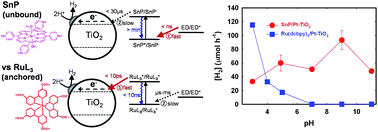Tin-porphyrin sensitized TiO2 for the production of H2 under visible light
Abstract

- This article is part of the themed collection: 2020 EES Lectureship Winner: Wooyul Kim
* Corresponding authors
a
School of Environmental Science and Engineering, Pohang University of Science and Technology (POSTECH), Pohang, Korea
E-mail:
wchoi@postech.edu
Fax: +82 54 279 8299
b The Institute of Scientific and Industrial Research (SANKEN), Osaka University, Mihogaoka 8-1, Ibaraki, Osaka, Japan
c Department of Applied Chemistry, Kumoh National Institute of Technonlogy, 1 Yangho-dong, Gumi, Korea

 Please wait while we load your content...
Something went wrong. Try again?
Please wait while we load your content...
Something went wrong. Try again?
W. Kim, T. Tachikawa, T. Majima, C. Li, H. Kim and W. Choi, Energy Environ. Sci., 2010, 3, 1789 DOI: 10.1039/C0EE00205D
To request permission to reproduce material from this article, please go to the Copyright Clearance Center request page.
If you are an author contributing to an RSC publication, you do not need to request permission provided correct acknowledgement is given.
If you are the author of this article, you do not need to request permission to reproduce figures and diagrams provided correct acknowledgement is given. If you want to reproduce the whole article in a third-party publication (excluding your thesis/dissertation for which permission is not required) please go to the Copyright Clearance Center request page.
Read more about how to correctly acknowledge RSC content.
 Fetching data from CrossRef.
Fetching data from CrossRef.
This may take some time to load.
Loading related content
